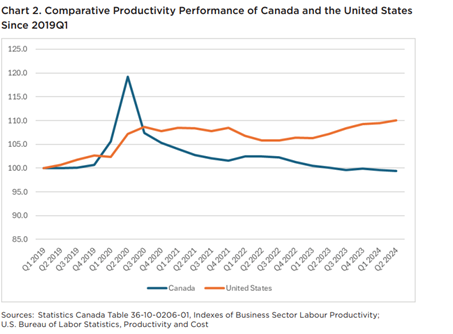Ending interprovincial trade barriers: from toilet seats and work boots to professional credentials and labour mobility
For lack of provincial agreement on toilet seats and work boots, Canada misses out on adding billions of dollars to its GDP.
 That’s an exaggeration. But it points to the very real problem of interprovincial trade barriers that – like death by a thousand cuts – business experts say are maiming Canada’s productivity and economic growth.
That’s an exaggeration. But it points to the very real problem of interprovincial trade barriers that – like death by a thousand cuts – business experts say are maiming Canada’s productivity and economic growth.
“There are thousands of individually modest but collectively significant barriers to investment in trade and migration,” Trevor Tombe (photo at right), professor of economics at the University of Calgary, told a panel session at Canada’s Productivity Summit in Calgary.
“It comes at great cost to productivity and living standards,” said Tombe, director of fiscal and economic policy at the School of Public Policy at UCalgary.
One of his studies on interprovincial trade barriers shows that internal trade has stagnated at 18 percent of GDP in recent years and is nearly 10 percentage points below its 27-percent share in 1981.
 “There is no greater problem than interprovincial trade barriers,” said Goldy Hyder (photo at left), president and CEO of the Business Council of Canada.
“There is no greater problem than interprovincial trade barriers,” said Goldy Hyder (photo at left), president and CEO of the Business Council of Canada.
Canada, through 15 trade agreements with 51 countries, trades with 1.5 billion people representing 61 percent of the global GDP, he said. “There’s more free trade inside the European Union with 27 countries, there’s more free trade inside the United States with 50 states, than there is inside Canada.”
Interprovincial trade barriers are standing in the way of increasing productivity and economic growth, which are necessary for Canada to be able to afford spending on health care, infrastructure, education and other public services, Hyder said.
 There are lots and lots of little barriers that are causing Canada big productivity challenges, said Laura Jones (photo at right), president and CEO of the Business Council of British Columbia. “It’s like we have this big pile of small rocks in the middle of our productivity road.”
There are lots and lots of little barriers that are causing Canada big productivity challenges, said Laura Jones (photo at right), president and CEO of the Business Council of British Columbia. “It’s like we have this big pile of small rocks in the middle of our productivity road.”
To try to address the problem, she said, the federal, provincial and territorial governments have been picking up one small “rock” at a time – one interprovincial trade barrier – and then trying to get 13 leaders from various levels of government to discuss whether to move the rock.
“If they agree on moving the rock, they each have to go back to their provincial cabinets to pass the regulations to allow them to move that rock. And then they wonder why people are frustrated,” Jones said.
“So we need to get out the bulldozer,” she said. “If we want big results, we need to think more boldly when it comes to policy.”
Tombe’s research has shown that interprovincial trade barriers are the equivalent of adding a 6.9-percent tariff on everything Canadians buy, Hyder noted.
“[Nearly] seven percent is effectively the price that Canadians are paying, without their knowledge, for services and goods that they’ve made and should be available freely to them in Canada as one country,” Hyder said.
Research for the International Monetary Fund by Tombe and colleagues has found that eliminating interprovincial trade barriers could add up to a 3.8-percent increase in Canada’s GDP – or nearly $90 billion per year – over $2,300 per person or over $6,000 per household.
Wages would increase if there was more interprovincial labour mobility, Hyder said. Research shows federal government revenues would rise by up to six percent and provincial revenues by up to four percent.
“We stand in our own way of progress, and interprovincial trade barriers are probably the poster child of something we’re doing to hurt ourselves more than anybody else can do to hurt us. We need to get out of our own way.”
Canadians unaware of cost of interprovincial trade barriers
But most Canadians are unaware of how pervasive interprovincial trade barriers are and how much such restrictions on the interprovincial movement of goods, services and labour mobility cost them, Hyder said.
During the COVID pandemic, differences among provinces on their required professional qualifications prevented health care professionals from moving within provinces, he noted. “Even in that pandemic, in a national crisis when lives were at stake, we got in our own way when it came to health professionals.”
The most well-known interprovincial barrier is the prohibition on moving alcohol or tobacco between provinces. But the barriers range from such things as toilet seats, work boots and first-aid kits, to meat and how hay shipments should be stacked – even standards defining a commercial “truck” vary from province to province
Jones pointed out that toilet seats manufactured for the construction sector in Ontario need to be able to be lifted, while fixed seats are acceptable in other provinces. So a manufacturer making fixed toilet seats can't sell them to the Ontario market.
Meat produced in Alberta can’t be shipped to British Columbia and be sold in grocery stores.
Biased government procurement means local construction firms and suppliers may be favoured on infrastructure projects, even if they are higher cost than out-of-province firms.
In Manitoba, one cannot offer legal services without maintaining a physical office in the province.
Government policies and regulations discourage competition and encourage interprovincial barriers on things like the spectrum of radio frequencies in telecommunications, airline and airport fees, bank charges and in many other sectors, Hyder said.
There are also technical and regulatory/administrative barriers when it comes to requirements within specific sectors, including licensing requirements and professional qualifications.
Denturists are not free to move into Quebec without re-certifying, for example, nor are podiatrists into Alberta, dental hygienists into Newfoundland and Labrador, social workers into Ontario, and so on.
“It’s the regs [regulations] that are keeping us from investing, the regs that are giving us the unpredictability and lack of stability, that are driving up costs, that are preventing us from getting the labour mobility that we need,” Hyder said.
Canada accepts immigrants on the basis of them having specific skills and qualifications to enable them to work in certain occupations here, he said. “That’s a lie. That has to stop.”
He said what often happens is that skilled immigrants come to Canada, only to have provincial professional bodies tell them they can’t work in the occupations they’re qualified in without first going back to school for more training.
There are waiting lists for health care services across Canada due to skilled labour shortages that are partly the result of restrictions on labour mobility and rules on professional credentials that vary from province to province, Hyder said.
“We need to push harder on how interprovincial trade barriers are standing in the way of delivering better quality health care in a more expeditious manner that we currently receive it.”
Without increased productivity and worker output, how is Canada going to grow its economy, create prosperity, and meet the needs of its aging population in 25 years? Hyder asked.
The federal government needs to use its convening power and bring together Ottawa, the provinces and the territories to start serious discussions about removing interprovincial trade barriers and how to do it as fast as possible, he said.
Ottawa could also leverage its spending power and require provinces to remove interprovincial trade barriers, which would increase Canada’s GDP and federal revenues, so Ottawa could transfer more money to the provinces, he suggested.
“We need a stronger federation. We need to function like a country. We need the leadership that a federal government is supposed to provide.”
Slow progress being made on some barriers, but bolder steps needed
Jones pointed out that there has been some progress, albeit slow and incremental, on work to begin removing some interprovincial trade barriers.
In 2017, the Canada Free Trade Agreement came into place, with a “reconciliation table” that, for the first time, provided a mechanism for provinces to address long-standing interprovincial trade barriers.
“The reconciliation table has done some good things, but we need to get a lot bolder,” Jones said.
For example, the reconciliation table has worked for seven years on barriers in about 30 different areas, including things like interprovincial requirements for work boots and first-aid kits. But there have been agreements in only 17 of these 30 areas, and these agreements have been fully implemented in only five areas across all provinces, she said.
Instead of making progress inch-by-inch, Jones said provinces should use a “mutual recognition” approach that recognizes and accepts the standards, rules and regulations used by other provinces across all sectors and occupations, from commercial trucking to doctors, registered nurses and lab technicians.
Such an approach would provide for exemptions, or a “negative list” of specific standards, rules and regulations that would require further negotiation before being mutually recognized, she said. This approach still respects that individual provinces have jurisdiction over their own regulatory standards.
“It would send an enormously positive message to international markets,” for which interprovincial trade barriers are a significant and confusing issue, Jones said. “The perception of Canada would change if we were to do something very bold on this file.”
Tombe noted that the Ontario government has taken a mutual recognition system approach with its first-in-Canada “As of Right” initiative. The “As of Right” exemption enables physicians, nurses, respiratory therapists and medical laboratory technologists registered in another Canadian province or territory to start working in Ontario without having first been registered with an Ontario health regulatory college.
In another step forward, under the Canada Free Trade Agreement, the Committee on Internal Trade in September announced a new mutual recognition pilot project for provincial regulatory requirements for the trucking sector, aimed at removing internal barriers to trade.
The project – the first of its kind in Canada – would mutually recognize provincial requirements in areas such as driver’s medical and training, time of day definitions and oversize truck standards.
A huge accomplishment, panelists told Canada’s Productivity Summit, is the New West Partnership Trade Agreement (NWPTA), which Hyder noted has worked for more than a decade across British Columbia, Alberta, Saskatchewan and Manitoba, with governments of different political stripes.
Under the NWPTA, which has a dispute resolution mechanism, the four provinces are the first jurisdictions in Canada to commit to full mutual recognition or reconciliation of their rules affecting trade, investment or labour mobility.
The Business Council of Canada has been trying to persuade Ontario to join the NWPTA, which Hyder said would leverage other provinces to join. But the response he usually hears is that it would cost some Ontario department or the provincial government lost revenues – in alcohol sales, for example.
“But that shouldn’t stand in the way of the country benefitting from four percent GDP growth [by eliminating interprovincial trade barriers],” he said, especially when Canada is facing a long-term forecast of about 1.2-percent GDP growth annually.
Making matters worse is the federal government’s Bill C-282, Hyder said. The proposed legislation would prohibit any Canadian concessions on tariffs or tariff rate quotas relating to federal and provincial supply management policies and systems that protect Canadian poultry, egg and dairy production from foreign competition.
The private member’s bill has been passed by the House of Commons and second reading in the Senate and is now being considered by a Senate committee.
Critics contend the bill protects a small, privileged group of farmers, results in higher prices for consumers, and will limit Canada’s negotiating flexibility in future trade talks.
“That bill is ludicrous for a country that is free-trading, saying that we’re going to exempt supply management discussions,” Hyder said. “It’s really rich for us to lecture countries on protectionism, when in fact we’re endorsing and practising it right here at home.”
Instead of such protectionist legislation, Canada needs to focus on quickly eliminating interprovincial trade barriers to increase productivity and growth, Hyder said. “If you’re not achieving growth in other places, but you have these handcuffs on yourself, the keys are available to you, you just have to open [the handcuffs] up and unleash.”
More than 700 business and community leaders attended Canada’s Productivity Summit, which was organized by the School of Public Policy, with the Government of Alberta as its presenting sponsor.
R$
| Organizations: | |
| People: | |
| Topics: |
Events For Leaders in
Science, Tech, Innovation, and Policy
Discuss and learn from those in the know at our virtual and in-person events.
See Upcoming Events
You have 0 free articles remaining.
Don't miss out - start your free trial today.
Start your FREE trial Already a member? Log in
By using this website, you agree to our use of cookies. We use cookies to provide you with a great experience and to help our website run effectively in accordance with our Privacy Policy and Terms of Service.




